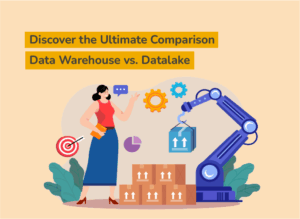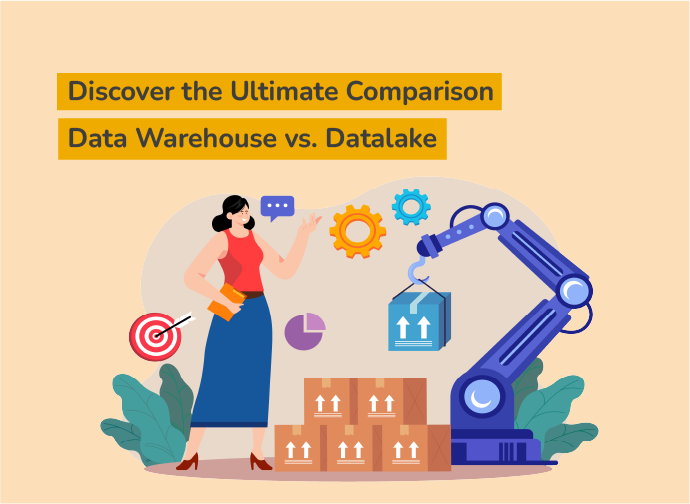What are Embedded Analytics?
Embedded analytics refers to the integration of analytical tools and capabilities directly into business applications. Unlike traditional analytics, which operate independently, embedded analytics are seamlessly woven into the software environments that companies use daily. This integration provides immediate access to key insights and facilitates data-driven decision-making, without the need to switch contexts or log into separate platforms. This synergy streamlines processes, improves efficiency, and enhances user experience. As businesses increasingly seek to harness real-time data, embedded analytics present a strategic advantage, making it a cornerstone technology in the modern data landscape.
| Aspect |
Traditional Analytics |
Embedded Analytics |
| Integration |
Separate platforms |
Embedded within apps |
| User Experience |
Context switching |
Seamless app use |
| Data Access |
Delayed |
Instant |
Key Takeaways
- Embedded analytics provide immediate access to insights by integrating analytical tools directly into business applications.
- Unlike traditional analytics, embedded analytics offer seamless, contextual insights within everyday workflows.
- Integrating embedded analytics can enhance decision-making, boost business performance, and provide a competitive edge.
- Embedded analytics are powered by real-time data visualization, interactive dashboards, and customized reporting.
- Real-time access to comprehensive data helps businesses make informed, timely decisions.
- Implementation of embedded analytics should focus on system compatibility, employee training, and strategic alignment.
- AI and machine learning are transforming embedded analytics, offering predictive capabilities and smarter decision-making processes.
Definition of embedded analytics
Embedded analytics refers to the integration of analytical capabilities directly within business applications, empowering users with actionable insights without the need to switch platforms. Unlike
traditional analytics, which often operate in separate environments, embedded analytics offers a seamless experience by embedding data-driven insights into everyday workflows. This approach enhances user experience by providing contextually relevant information, enabling quicker decision-making and improved business processes. By embedding analytics, businesses can turn raw data into meaningful insights, fostering a data-driven culture that supports innovation and growth.
How embedded analytics differ from traditional analytics
Embedded analytics
integrate data analytics directly within business applications, streamlining access to insights at the point of decision-making. Unlike traditional analytics, which necessitates switching between separate platforms and tools, embedded analytics offer seamless, contextual insights. This approach
reduces the time to insight and enhances data utilization by providing relevant analytics within everyday workflows. As a result, decision-makers can foresee emerging trends, make informed choices, and enhance operational efficiency without leaving their primary business systems.
Why Use Embedded Analytics?
Integrating
embedded analytics into business applications offers substantial
benefits by enhancing
decision-making and boosting
business performance. Unlike traditional analytics, embedded analytics seamlessly incorporate insights directly within applications, streamlining the process for users. This integration allows for real-time access to comprehensive data, enabling more informed and timely decisions. Businesses can uncover actionable insights and drive performance improvements without switching between systems. By leveraging these analytics, companies can gain a competitive edge, reduce operational inefficiencies, and increase profitability, aligning all levels of operation with strategic goals.
„Key advantages of leveraging embedded analytics include improved decision-making speed and enhanced data-driven strategies, contributing to overall business performance enhancements.“
Benefits of integrating analytics into business applications
Integrating
embedded analytics into business applications offers transformative benefits that extend beyond traditional analytics solutions. By embedding analytics directly into everyday business tools, companies can ensure
real-time data accessibility, enhancing
decision-making processes and driving
business performance. This seamless integration empowers users with personalized insights, fostering a
data-driven culture within the organization. Moreover, it provides a
unified view of data, reducing the need for disparate systems and improving overall efficiency. Businesses can harness the full potential of their data assets, enabling quicker
insights and informed
strategic planning.
- Real-time data accessibility
- Enhanced decision-making
- Personalized insights
- Data-driven culture
- Unified data view
- Improved efficiency
Impact on decision-making and business performance
Embedded
analytics revolutionize
decision-making and
business performance by seamlessly integrating actionable insights into everyday applications. These
data-driven tools empower businesses to proactively respond to market changes and make informed decisions with unprecedented speed and accuracy. By embedding analytics directly into business processes, organizations can harness real-time insights, fostering a culture of
innovation and
agility. This strategic approach not only enhances efficiency but also drives
competitive advantage by uncovering hidden opportunities within the operational framework.
- Streamlined decision-making
- Enhanced business performance
- Real-time insights
- Competitive advantage
How Do Embedded Analytics Unlock Hidden Insights?
Embedded analytics unlocks hidden insights by seamlessly integrating
analytical capabilities into everyday applications. This allows businesses to uncover
data patterns traditionally overlooked. By embedding analytics, companies can access contextual insights without disrupting workflows, thus leading to more proactive decision-making. Techniques such as
automated reporting and
predictive analytics help in identifying trends and anomalies that can directly impact business strategies. Successful case studies show significant improvements in operational efficiency and strategic foresight because of these insights. The ability to integrate these analytics into various applications facilitates a nuanced understanding of data, transforming how organizations interpret information.
Techniques for revealing hidden data patterns
Embedded analytics are revolutionizing how businesses discover hidden data patterns by seamlessly integrating advanced data analysis tools within everyday business applications. These techniques elevate traditional analytics by enabling users to uncover and visualize data correlations, anomalies, and trends. With methods such as predictive analytics, data mining, and AI algorithms, organizations can transform vast data sets into actionable insights. This empowers businesses to make informed strategic decisions and drive performance improvements. Implementing these techniques optimizes various operational aspects, thus enhancing efficiency and competitiveness in the market.
Case studies of successful implementation
Embedded analytics has transformed how businesses operate by seamlessly integrating data analysis within their applications. Several case studies illustrate its successful implementation. Companies have leveraged these capabilities to unearth valuable insights previously hidden in vast datasets. For instance, a retail firm utilizing embedded analytics identified purchasing trends, boosting sales by targeting specific demographics. Another example is a healthcare provider that improved patient outcomes through predictive analytics. They seamlessly incorporated data insights into their processes, enabling real-time decisions. These success stories highlight the transformative power of embedded analytics, driving innovation and delivering tangible returns.
What are the Key Features of Embedded Analytics?
Embedded Analytics offer powerful features that transform how businesses leverage their data. These features include
interactive dashboards and
comprehensive reporting, providing users with real-time data insights.
Data visualization tools bring clarity to complex datasets, aiding swift decision-making. Embedded analytics seamlessly integrate into existing business applications, offering continuous data interaction without switching platforms. They also feature
customizable reports and
predictive analytics, enabling personalized insights tailored to specific business needs. Such integration boosts efficiency and reliability in data-driven decisions. By enhancing user engagement and insights, these tools are invaluable in uncovering actionable intelligence from data.
In-depth exploration of features like dashboards and reporting
Embedded analytics is revolutionizing the way businesses consume and interpret data by integrating features like
dashboards and
reporting directly into their applications. These tools offer
real-time insights into complex data sets, empowering users to make data-driven decisions more efficiently. Unlike traditional analytics, which often require users to switch platforms, embedded analytics deliver information seamlessly within the software you already use. This integration allows for customized views and reports, tailored to meet specific business needs, enhancing user engagement and improving overall performance.
Real-time data visualization
Real-time data visualization is a pivotal feature of embedded analytics, offering immediate insights into business operations. Unlike traditional analytics that focus on static data analysis, embedded analytics enable dynamic, real-time access, empowering users to make informed decisions swiftly. This capability enhances decision-making by providing up-to-date information through intuitive dashboards and interactive reporting. Users can identify trends and anomalies as they occur, ensuring timely responses to market changes. Real-time visualization integrates seamlessly into existing applications, delivering a user-friendly experience that increases data-driven culture across the organization.
How to Implement Embedded Analytics in Your Business?
Integrating embedded analytics into your business systems can dramatically enhance decision-making capabilities and operational efficiency. To successfully implement these solutions, begin by evaluating current data infrastructure for compatibility with analytics tools. Next, select the right platforms that support seamless integration. Focus on tailoring the analytics to fit your specific business needs, ensuring the tool’s features align with your strategic goals. Training employees and conducting pilot tests are crucial steps to address potential challenges and facilitate smooth adoption. By embedding analytics, businesses can gain real-time insights, uncovering trends that boost performance.
Steps to integrate embedded analytics into existing systems
Integrating embedded analytics into existing systems requires a methodical approach to ensure seamless integration and maximum utility. Begin by identifying the core business applications where analytics can add significant value. Next, choose the right tools and platforms that support integration and complement your system architecture. Data accuracy is crucial, so ensure robust data management and cleansing practices. Implement user-friendly dashboards and visualizations to promote data-driven decisions. Finally, provide continuous training for users to harness full potential, adapting workflows to leverage insights efficiently.
Tools and platforms that support embedded analytics
Choosing the right
tools and platforms can significantly enhance your embedded analytics capabilities. There are numerous options designed to integrate seamlessly with existing systems, each offering unique features. Popular platforms provide
intuitive interfaces, real-time capabilities, and support diverse datasets to deliver actionable insights. Some tools focus on
customization and scalability, allowing businesses to tailor analytics according to their needs. It is crucial to evaluate factors such as
compatibility, ease of use, and cost-effectiveness when selecting the most suitable solution, ensuring alignment with company goals and facilitating a smooth analytics integration.
What are the Challenges of Using Embedded Analytics?
Implementing
embedded analytics can revolutionize business operations, but it comes with its own set of challenges. One major hurdle is integrating analytics into existing systems without disrupting operations. Businesses often face
data privacy and security concerns due to increased data access. Ensuring real-time data accuracy and maintaining high performance can strain resources. Without proper skills, teams may struggle to
interpret and leverage analytics effectively. Solutions include training, robust security measures, and choosing the right tools and platforms to ensure a seamless integration and
maximize the benefits of embedded analytics.
Common obstacles businesses face
Implementing embedded analytics can present several challenges for businesses, primarily due to integration complexity and data security concerns. Many organizations find it difficult to seamlessly blend analytics into their existing systems without disrupting workflows. Additionally, ensuring robust security measures to protect sensitive data can be arduous, especially when dealing with diverse data sources. Moreover, achieving user adoption poses a significant hurdle since employees may resist changes to their routine processes. Overcoming these obstacles requires careful planning, staff training, and choosing the right tools that offer scalability and flexibility.
Solutions to overcome these challenges
Navigating the challenges of embedded analytics can seem daunting, but by adopting strategic solutions, businesses can leverage its potential effectively.
Data privacy concerns can be addressed through robust encryption and compliance standards.
Integration issues are manageable with scalable and flexible platforms. To combat
user adoption barriers, provide comprehensive training and support. Key is to ensure seamless compatibility with existing systems. By deploying these targeted solutions, businesses can harness the full power of embedded analytics, driving insights and
enhancing decision-making capabilities.
What are the Future Trends in Embedded Analytics?
The future of embedded analytics is set to revolutionize how businesses leverage data, making it more accessible and actionable. As AI and machine learning continue to evolve, they are expected to play a crucial role in enhancing analytics functionality, enabling more intuitive data interactions and smarter decision-making. The integration of real-time data processing and predictive analytics will further empower companies, offering deeper insights and fostering innovation across industries. Businesses must stay abreast of these trends to remain competitive, ensuring their analytics solutions are agile, scalable, and capable of adapting to future demands.
| Future Trends in Embedded Analytics |
| AI and Machine Learning Integration |
| Real-time Data Processing |
| Predictive Analytics Utilization |
| Smarter Decision-Making Solutions |
Predictions for the evolution of embedded analytics
Embedded analytics are set to transform the analytics landscape with many exciting trends on the horizon.
AI and
machine learning will play pivotal roles in advancing the capabilities of these tools, enabling more intuitive data
interpretation. As predictive analytics become more integrated, businesses can foresee trends and make proactive decisions. The demand for real-time analytics and
customizable dashboards will rise, providing users with immediate insights tailored to their needs. Collaboration between analytics platforms and various business applications will gain momentum, enhancing operational efficiency and effectiveness, ensuring embedded analytics remain at the forefront of decision-making.
The role of AI and machine learning
AI and
machine learning are transforming the landscape of
embedded analytics, acting as critical drivers for growth and innovation. By automating data processing and analysis, AI elevates analytics capabilities, enabling businesses to generate real-time, actionable insights. Machine learning algorithms uncover patterns and trends, offering predictive analytics that guide strategic decisions. As organizations embrace these advanced technologies, the integration of AI and machine learning within embedded analytics not only enhances their analytical prowess but also ensures they stay competitive in an ever-evolving market. This synergy promises a future where data-driven insights are instantly accessible and tailored to specific business needs.
FAQ
What are embedded analytics?
Embedded analytics refers to the integration of analytical tools and capabilities directly into business applications, providing immediate access to insights without switching platforms.
How do embedded analytics differ from traditional analytics?
Unlike traditional analytics that operate on separate platforms, embedded analytics integrate directly into business applications, offering seamless and contextual insights.
Why should businesses use embedded analytics?
By integrating embedded analytics, businesses can enhance decision-making, boost performance, and gain a competitive edge through real-time, seamless access to comprehensive data.
What are the key features of embedded analytics?
Embedded analytics offer features like interactive dashboards, data visualization tools, and predictive analytics for real-time insights and enhanced decision-making.
How can businesses implement embedded analytics?
To integrate embedded analytics, businesses should evaluate current infrastructure, select compatible platforms, customize analytics to business needs, and train employees effectively.
What challenges do companies face when using embedded analytics?
Companies may face integration complexities, data security concerns, and user adoption challenges when implementing embedded analytics.
What future trends are expected in embedded analytics?
AI and machine learning will enhance embedded analytics, offering smarter decision-making and more intuitive data interactions, while real-time processing and predictive analytics will become more prevalent.









